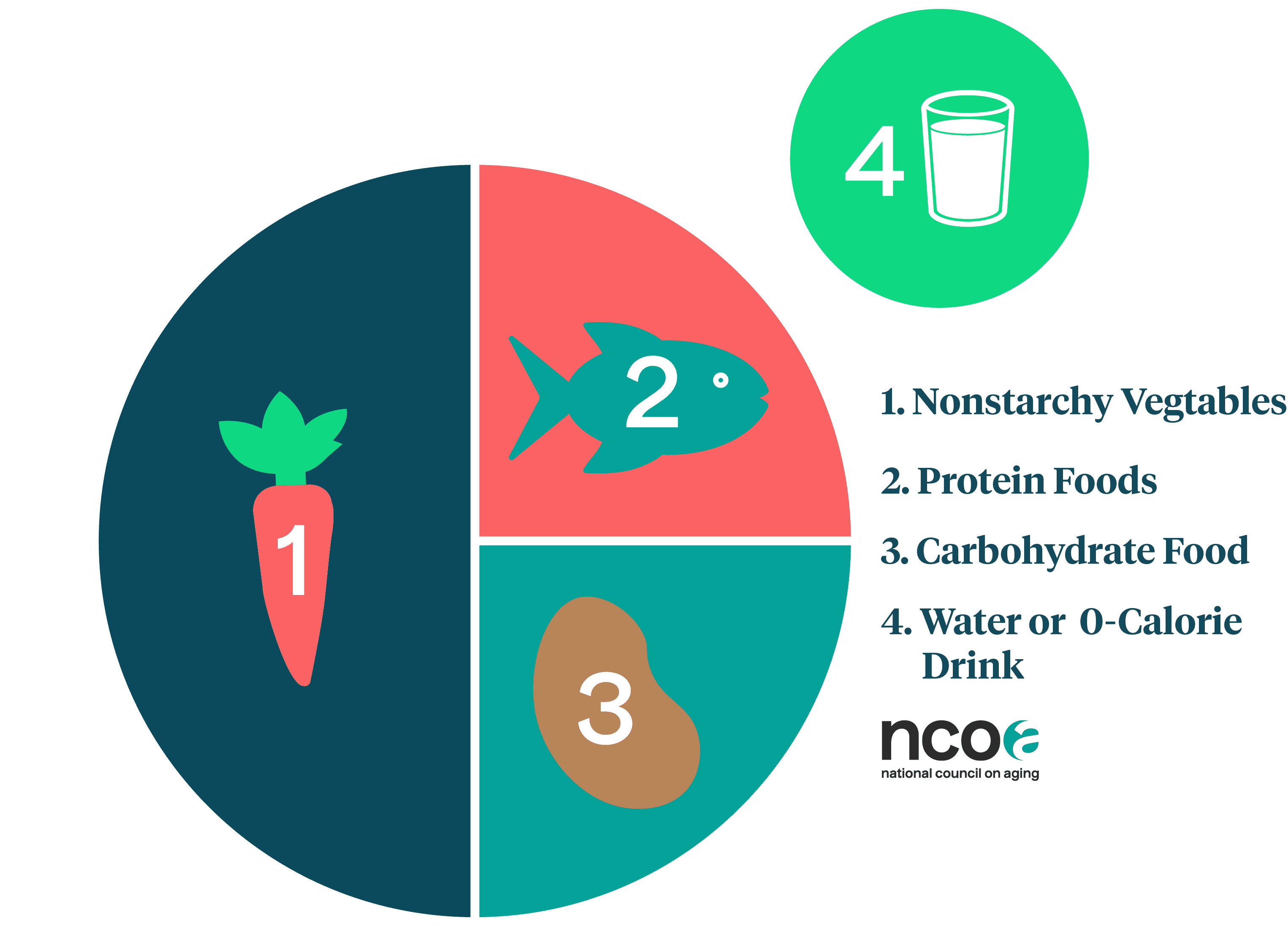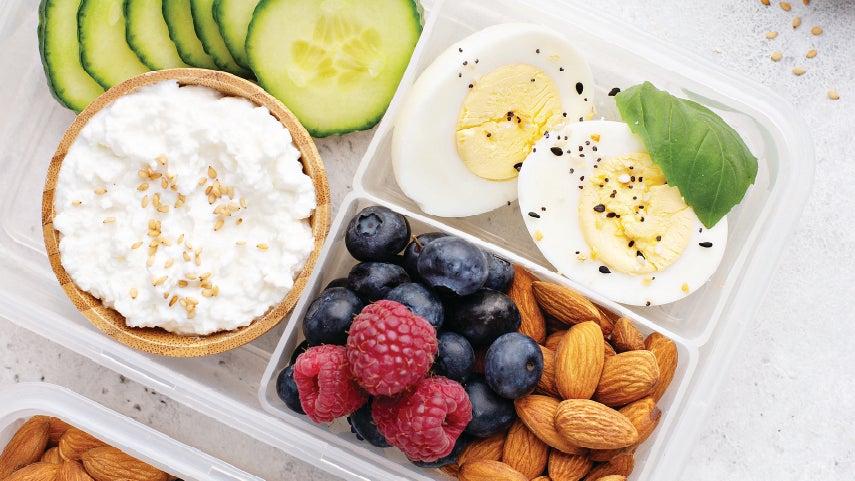
Related Topics
Managing diabetes in older adults requires a multi-faceted approach. One important aspect of living well with diabetes is good nutrition. By watching what you eat, you can help keep your condition under control, improve your quality of life, and stay healthy for longer. According to the American Diabetes Association, everyone's body responds differently to different types of foods and diets—so there’s no single "magic" diet for diabetes.
Why is it important to eat healthy when you have diabetes?
When we consume certain foods, our blood glucose levels rise. This poses a problem for people with diabetes, whose bodies are unable to properly manage these spikes in blood sugar. In fact, if blood sugar isn’t managed, older adults with diabetes can develop hyperglycemia, a state of perilously high blood glucose. Untreated hyperglycemia poses grave health risks, including diabetic coma (ketoacidosis). It can also cause other, long-term diabetes complications such as kidney disease, eye disease, and heart attacks.
Fortunately, the opposite is true as well. Following a diet plan that's nutrient-dense and low in fat and calories can help you keep your blood sugar levels in a safe range and prevent health complications.
How does diabetes impact senior nutritional needs?
The first step in managing diabetes through diet as an older adult is to understand how different nutrients affect blood glucose levels. A balanced blend of high-fiber carbohydrates, lean protein, and healthy fats can help you maintain stable blood sugar levels and prevent dangerous fluctuations. Below are more insights into each of these important nutrients.
Carbohydrates
The starches (complex carbohydrates) and sugars (simple carbohydrates) in food are converted into blood glucose after we eat them. That's why controlling carbohydrates is a key part of controlling diabetes. According to the Centers for Disease Control and Prevention (CDC), people with diabetes should aim to get half of their total daily calories from carbs.
Complex carbohydrates are more diabetes-friendly than simple carbs—since they contain more fiber and other nutrients and are digested more slowly. The slower rate of digestion in turn slows the release of glucose into your bloodstream.
What this means for you: Focus on healthy complex carbs that are rich in fiber, vitamins, and minerals and low in sodium, unhealthy fats, and added sugars. Eating roughly the same amount of carbs at each meal can help you keep your blood sugar consistent throughout the day.
Nutrient-dense carbohydrates include:
- Fruits and vegetables
- Beans and lentils
- Whole-grain cereals, breads, and crackers
- Whole grains such as oats, barley, bulgur, and buckwheat
- Dried fruit and nuts
Protein
Protein provides our body with amino acids—the building blocks responsible for building and repairing tissue such as muscle. Getting enough protein is especially important for older adults, who lose up to 50% of their muscle mass between the ages of 40 and 80.1 A protein-rich meal can also help you feel fuller faster and stay satisfied for longer, so you’re less inclined to snack on unhealthy fare.
When carbohydrates are not available, protein can also supply the body with energy. Since protein-based foods are digested much more slowly than carbs—and generally don't provide glucose—they don't significantly impact blood sugar.
What this means for you: It is recommended that older adults consume 1.0-1.2 grams of protein per kilogram of body weight.2 For example, an older adult who weighs 150 punds (68 kg) should eat 68-82 grams of protein per day. Aim to spread your protein intake evenly througohout the day with 20-30 grams at mealtimes and 12-15 grams with snacks.3
Some good lean-protein choices for diabetes management include:
- Poultry such as chicken and turkey
- Skinless fish
- Leaner cuts of beef
- Tofu
- Eggs
- Low-fat dairy, such as cheese and Greek yogurt
- Nuts and nut butter
- Pumpkin seeds
- Beans and legumes, such as black and kidney beans, chickpeas, and lentils
Fat
There's a common misconception that older adults with diabetes should avoid fat altogether. Not true! Your body needs fat to function properly. Like high-fiber carbohydrates and protein, fat is digested at a slower pace and only minimally impacts blood glucose levels. However, consuming excess fat can lead to insulin resistance and prolonged high blood sugar levels and negatively affect your heart health. And, since fat is high in calories, eating too much of it can cause weight gain.
What this means for you: Not all fats are created equal. The key is to focus on foods with heart-healthy monounsaturated and polyunsaturated fats—and eat them in moderation.
These foods include:
- Avocados
- Nuts (e.g., walnuts)
- Seeds (e.g., chia seed, flaxseed)
- Canola, olive, sunflower, and peanut oils
How often should older adults with diabetes eat during the day?
When you’re living with diabetes, a consistent amount of carbohydrates at fixed times for meals and snacks can help you keep your blood glucose levels steady. This provides you with a stable supply of energy and prevents “crashes” caused by dips in blood sugar. The amount of carbohydrates per meal or snack will depend on your age, weight, activity level, and other factors. A registered dietitan nutritionist (RDN) or certified diabetes care and education specialist (CDCES) can help you create an eating plan that's tailored to your needs and lifestyle.4
What foods should diabetic seniors avoid or limit?
One of the main things to limit on a diabetes eating plan is sugar. Table sugar and even artificial sweeteners cause blood glucose to spike, which can lead to hyperglycemia. You can prevent this by avoiding sugary foods such as donuts, candy, pastries, soda, and honey. Other foods to eat in moderation when you have diabetes include:
- Refined carbs: These are carbohydrates that have been stripped of their fiber and other vital nutrients. As a result, foods with refined carbs—like white bread—are generally digested faster and can cause glucose levels to rise quickly. A better bet is to choose foods with complex carbohydrates, such as whole-grain bread.
- High-fat dairy and animal products: Foods like bacon, sausage, and butter are high in saturated fat, which can cause clogged arteries and heart disease. Opt instead for lean meats and poultry and an olive oil spread versus butter.
- Deep-fried foods: As tasty as it may be, fried chicken, French fries, chips, and other fried fare tends to be cooked in unhealthy oils (e.g., trans fats). Often, they're coated in breading, which adds excess calories. Choose food that is baked, broiled, or roasted instead of fried.
- Processed foods: Pre-packaged food, such as TV dinners, cookies, and frozen pizza, are often high in sugar, sodium, and unhealthy fats. A better option is to prepare your meals using fresh ingredients. Enlist the help of a friend or family member or hire a meal service if you have trouble preparing meals yourself.
- Alcoholic beverages: Alcohol can have a negative interaction with medications frequently used to treat diabetes (e.g., insulin), leading to low blood sugar. Alcoholic drinks may also be high in empty calories and can lead to overeating. Additionally, drinking heavily can cause liver damage and other diabetic health complications.
The bottom line? Consume alcoholic drinks with caution, and know how certain beverages can affect your blood sugar. Drink plenty of water—staying hydrated can prevent you from getting too intoxicated. It's also a good idea to wear identification (such as a MedicAlert bracelet) indicating you have diabetes. Intoxication and dangerously low blood sugar are often difficult to tell apart.
What is the Diabetes Plate Method?
It's important to understand not only what's best to eat when you have diabetes, but also how much to eat. The Diabetes Plate Method makes it easy to put together healthy meals that help you manage your blood glucose. The first step is using a plate that's about 9" in diameter. Next, imagine your plate is broken up into three sections (see diagram below).

1. Fill half your plate with non-starchy vegetables: These low-carbohydrate vegetables have minimal impact on your blood sugar and are rich in nutrients. Some examples are:
- Carrots
- Cabbage
- Eggplant
- Broccoli or cauliflower
- Celery
- Cucumber
2. Fill one-quarter of your plate with lean protein: Lean-protein foods are lower in saturated fat, which is better for your heart. Choose foods such as:
- Chicken, turkey, and lean cuts of pork (e.g., tenderloin)
- Eggs
- Beans, hummus, and lentils
- Nuts and nut butters
- Fish like tuna, cod, salmon, and tilapia
- Cheese and cottage cheese
3. Fill one-quarter of your plate with carbohydrate foods: High-carbohydrate foods have the biggest impact on your blood sugar levels. Limiting them can help you prevent glucose spikes after meals. These foods include:
- Starchy vegetables like green peas, potatoes, and acorn squash
- Fruits (including dried fruit)
- Whole grains such as brown rice, quinoa, and oatmeal
- Whole-grain products such as bread and pasta
- Milk, yogurt, and other dairy products
- Beans and legumes such as black beans and kidney beans
4. Choose water or a low-calorie drink: Water is the best thirst-quencher since it's free of calories and carbs and doesn't raise blood glucose levels. Other beverage options include:
- Sparkling water
- Diet soda and other diet drinks
- Unsweetened tea, hot or iced
- Unsweetened coffee, hot or iced
A diabetes diet plan doesn't have to be restrictive—or dull! Working with a registered dietitian/nutritionist or finding diabetes-friendly recipes online can help you create a varied plan that’s tailored to your specific needs and tastes. By eating well, you can prevent dramatic blood sugar fluctuations that can potentially lead to major complications. What’s more, you’ll reap other benefits, too—such as a lower risk of heart disease, stronger bones, weight loss, and more.
Visit our Diabetes for Older Adults resource library for more smart tips on managing your diabetes.
Sources
1. How Older Adults Can Meet Their Protein Needs, Consumer Reports. Found on the internet at https://www.consumerreports.org/healthy-eating/how-older-adults-can-meet-their-protein-needs-a8954254493/
2. The National Resource Center on Nutrition and Aging. Nutrition Needs for Older Adults: Protein. Found on the internet at https://acl.gov/sites/default/files/nutrition/Nutrition-Needs_Protein_FINAL-2.18.20_508.pdf
3. AARP. Should You Get More Protein? Found on the internet at https://www.aarp.org/health/healthy-living/info-2019/how-much-protein-do-you-need.html
4. Centers for Disease Control and Prevention. Carb Counting. Found on the internet at https://www.cdc.gov/diabetes/managing/eat-well/diabetes-and-carbohydrates.html



